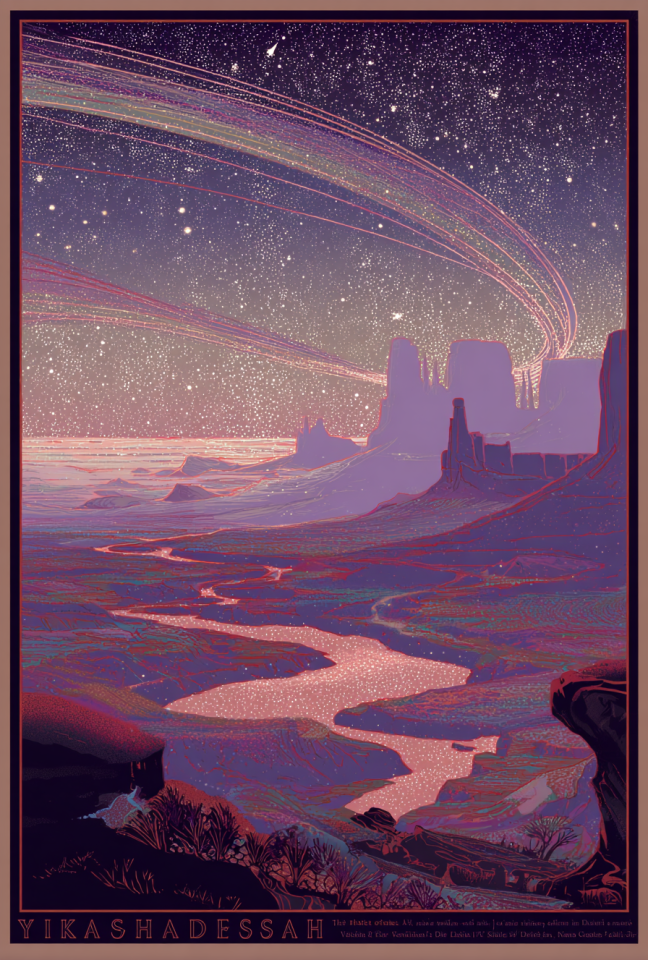Yikáísdáhá, “That Which Awaits in the Twilight,” is the sacred borderland between day and night, between worlds, between knowing and unknowing. Governed by Kookyangwso’wuuti — the revered Grandmother Spider — it is a realm of subtle weaving and cosmic patience. Neither wholly light nor shadow, Yikáísdáhá cradles the in-between, holding stories before they are told, spirits before they are born, and knowledge before it becomes word. It is here that the first maps of being were spun from silk and silence. Though once accessible through ritual, trance, and starlight, Yikáísdáhá now lies gently sealed beyond the Veil — but never forgotten.
Landscape and Essence
Yikáísdáhá is a realm woven of threads, light, and dust suspended in an eternal dusk where stars begin to form but have not yet taken their places. The land glows in soft purples and deep reds, with mesas that float weightlessly and canyons that speak when you are still enough to listen. Threads of shimmering silver crisscross the air — strands of story, prophecy, fate, and memory. The realm pulses with the gentle rhythm of weaving: a constant, almost imperceptible thrum. Spirals appear naturally — in stone, light, path. Wind moves slowly, and even the silence seems to spin. It is a place where nothing is rushed, and everything is seen.
Inhabitants
At the center of this realm sits Kookyangwso’wuuti the Spider Grandmother — ancient beyond age, her form shifting from old woman to great silver spider to constellation. She does not command; she weaves. Around her are helpers and echoes : coyote-tricksters, ancestor-shades, duskbirds, and thread spirits — each embodying a pattern or lesson. These beings do not dwell in palaces or courts but move through the fabric of the realm, tending to the stories and spirits caught in its web. Some are weavers, others watchers, some merely wander — but all are intentional. Lost souls sometimes appear here, not trapped, but offered a place to rest, to reflect, or to be rewoven.
Cultural Significance
For many Indigenous cultures across the American Southwest, the figure of Grandmother Spider is central to creation, wisdom, and sacred order. She wove the world into being, taught the people how to speak, to record, to survive. In ritual and oral tradition, Yikáísdáhá — though not always named — was understood as a liminal zone, where the veil between realms was thinnest. Vision quests, sand paintings, and ceremonial dances often drew upon its imagery. The spiral, the web, the cross — these all echoed the shape of this sacred place. Colonization severed many direct connections, and with the silencing of languages and the breaking of lineages, the web frayed. But it never broke. Yikáísdáhá remains, whispering in the twilight.
Role in the Divine Realm
Yikáísdáhá is the weaver’s workshop of the cosmos — not the origin of creation, but its continuity. While other realms govern law, light, or reward, Yikáísdáhá maintains connection. It is where destinies are tied where spirits receive guidance before returning, where events are gently nudged toward balance. It holds the unfinished, the overlooked, the in-process. It serves as the cosmic editor, making sense of chaos without erasing it. Its influence is subtle but essential — even gods must acknowledge the web.
Interactions with Other Realms
Yikáísdáhá has always bordered many realms — and many Realms once bordered it. The twilight hour, the desert horizon, the ceremonial spiral — these were once passage points. Mortals could slip into the realm through storytelling, trance, fasting, or craft. Children, the dying, and visionaries often passed near it. But as sacred practices were suppressed and memory disrupted, the pathways faded. Now, only Grandmother Spider, her chosen spirits, and certain shamans may cross freely. Yet, every dream that lingers too long, every prophecy carved into pottery, every feathered whisper in the dusk — these are pieces of Yikáísdáhá, still slipping through.
















